Like everyone else, I love the idea of “one gun to rule them all.” Actually, maybe I like the idea little more than everyone else. Those of you familiar with the blog know that two of my big interests are handguns and survival. So why not an article about the ultimate wilderness survival handgun?
The Ultimate Wilderness Survival Handgun
First things first: why a handgun? A rifle would, without question, be much more useful for survival. Unfortunately carrying a rifle is never as easy as carrying a handgun. For example, on SAR callouts I am permitted to carry a concealed handgun in accordance with my state’s laws. I am not permitted to carry a rifle, and carrying one would consume precious pack space, or be inappropriate to carry openly on a rescue operation.
Recently I was on a search with my 1911 on my side. I carry it because it’s what I always carry. But is the best choice for the woods? This got me thinking, “what is my ideal ‘trail’ gun? What is my ideal ‘survival’ gun?” That seed of a thought sparked this entire line of thinking and here we are.
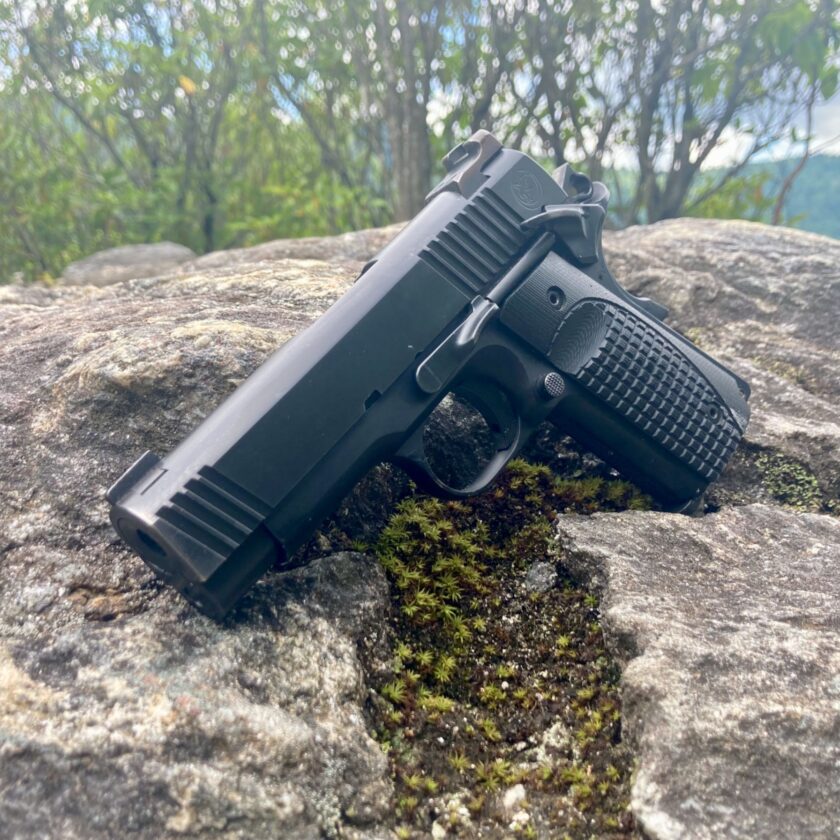
Generally when I talk about guns on this blog I stay fully within the realm of reality. I have reviewed a few guns, and so far I’ve never ventured into talking about guns that don’t exist. But I’m going to do that today. Today I’m going to imagine a gun that doesn’t exist…with a caveat.
Everything I’m going to imagine is fully within the realm of possibility. No serious engineering would be required to make such a handgun. None of the features I am requesting are unavailable on the market currently, but no one gun combines them all. Several handguns on the market get pretty close (one gets really, really close), and we’ll look at some of those at the end of the article.
My Definition of “Survival”
I know there are multiple definitions of “survival.” Mine is, I believe, fairly realistic. I am not looking for a gun with which to survive the apocalypse or TEOTWAWKI or to maraud my way through some urban hellscape. My definition of a “survival” handgun is something that could be as versatile and useful as possible in a wilderness survival situation.
The ultimate wilderness survival handgun should do a couple of things. First, it should be be able to use to mount a defense of oneself against a human attacker. It likely won’t be the ideal firearm, but since we won’t carry two handguns, it should do at least an OK job in this role, since human attacks don’t stop where the wilderness begins.
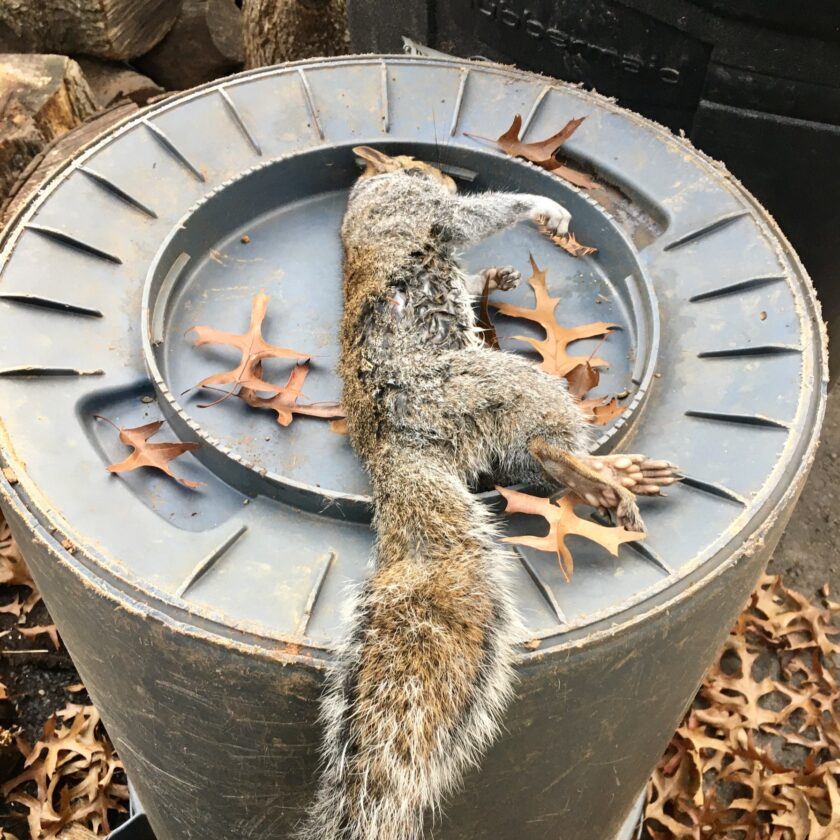
Next, it should be able to take small game, from squirrels and rabbits up to larger animals like raccoons, groundhogs, and beaver. Hunting small game necessitates accuracy, so the gun should be accurate enough for the job. It should also be powerful enough; during survival it may be necessary to take shots that don’t guarantee a clean kill, but we’d still like to avoid it when possible.
And that’s about it. Animal attacks are so exceedingly rare that animal defense isn’t even on my radar. And if you do need to defend yourself against a bear it appears that a .22 is about as good as anything else. Killing snakes? Please…snakes don’t want to bother you. My eyes audibly roll when I hear someone talk about “dealing with” snakes.
With that definition of survival in mind, let’s talk about what my ultimate wilderness survival handgun looks like!
Bottom Line Up Front
I guess there’s no sense beating around the bush. I intended to list a bunch of criteria that could apply to anything before letting the cat out of the bag, but let’s get right to it. The ultimate wilderness survival handgun for me would be described as a:
- DA/SA revolver,
- chambered in .22 Magnum,
- with an 8- or 9-round capacity,
- a medium, round-butt frame,
- a 4″ barrel,
- medium overall weight, with
- excellent adjustable sights, and
- made of weather-impervious materials.
I know this might not be the ideal for many people, but I think this is about the perfect combination. Allow me to explain why this is my ultimate wilderness survival handgun. I will try to break down each one of these specifications.
Chambering: .22 Magnum
To my mind the most appropriate caliber for my ultimate wilderness survival handgun is .22 Winchester Magnum Rimfire, aka .22 Magnum. Why the lowly rimfire? First and foremost, I really like .22 Magnum. I’m not sure why, but it really appeals to me. But I also think it brings a lot to the table. Since this choice dictates a lot of the other specifications of the gun I’ll spend some time making my case for the .22 WMR cartridge.
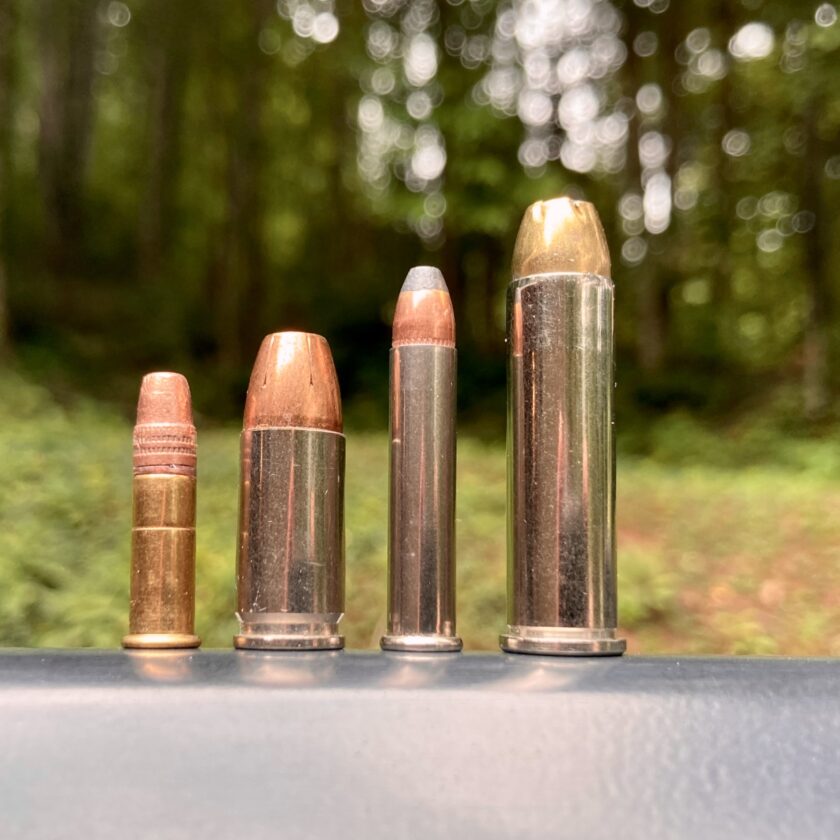
Cost & Availability
Though logistical factors should play second fiddle, in reality they don’t. Your “perfect” gun is no good if you can’t find ammo for it. Likewise if you can’t afford to practice with it and stockpile some ammo. The .22 Mag is a pretty popular cartridge and plenty of ammo is available for it. You can also find a pretty wide range of cartridges to meet a variety of applications from FMJ ammo to purpose-built defensive loads.
Twenty-two Magnum is also (fairly) inexpensive. It isn’t as cheap as .22 LR, but it’s not some boutique cartridge, either. Here is a quick cost comparison at SGAmmo.com, at the time of this writing:
- Cheapest .22 LR: $0.08 per round
- Cheapest brass-cased 9mm: $0.35 per round
- Cheapest .22 Magnum: $0.36 per round
- Cheapest .38 Special: $0.66 per round
- Cheapest .357 Magnum: $1.38 per round
Obviously .22 Magnum ammo is several times more expensive than .22 LR, but you also get a lot more performance out of the longer rimfire. Costs for ammo are on par with 9mm, and close half the price of .38 Special. The reason .357 is over twice the price of .38 is availability. Bulk, practice loads in .357 are pretty much non-existent right now. Availability of ammunition is kind of a big deal.
Compact & Lightweight
Cartridges for the .22 Magnum are smaller and lighter than almost any centerfire round. Three boxes containing 150 .22 Magnum cartridges weighs only an ounce more (27.3 ounces) than a single box of .357 Magnum ammunition (26.3 ounces, by my kitchen scale), and it doesn’t take up much more space.
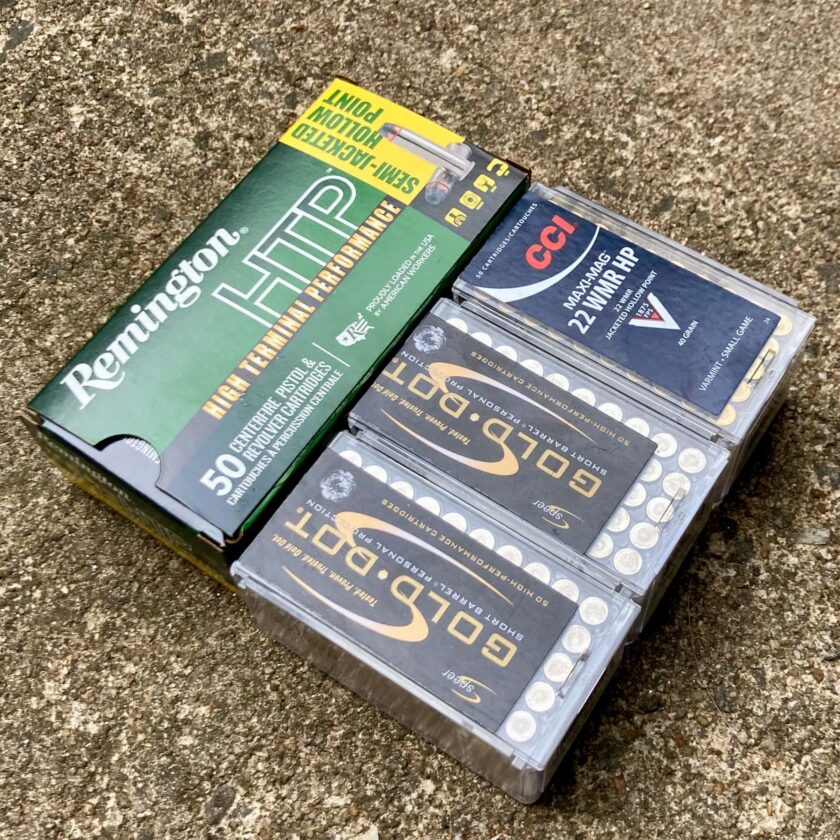
Obviously this is an important criteria in a survival cartridge. As it may well never be used, making carry onerous does not promote consistent carry of the arm or a spare box or two of ammunition. Not that one has to carry 150 rounds. Even a single box of 50 would almost certainly outlast any plausible survival scenario. If I had such a gun I’m pretty sure I’d ditch the ammo box and vacuum pack 50 rounds, and I’m equally sure I could find room for it in my pack.
Performance
The .22 Magnum offers better performance than the .22 Long Rifle, and in a couple of ways. The first is reliability. Although not as reliable as centerfire ammo, .22 Magnum ammo is maybe a tad more reliable than .22 LR ammo. I’ve noticed this and it’s been pointed out by Chris Lucky Gunner who shoots a heck of a lot more rimfire ammo than I do.
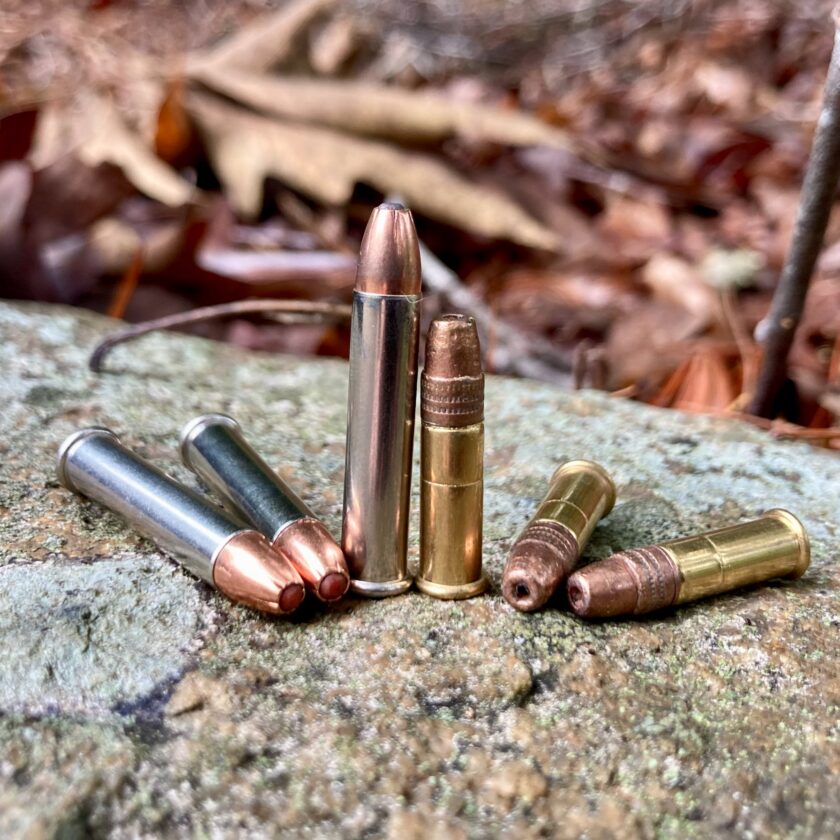
Next is bullet velocity, penetration, and expansion. The .22 Magnum performs, from a handgun, similarly to how the .22 LR performs from a rifle in terms of bullet velocity and energy. The .22 WMR can – unarguably – harvest larger game than the .22 LR, all other things being equal. Animals that might only be wounded and escape – depriving you a of a meal and enduring a needlessly painful death – might be taken with the .22 WMR.
Further, the .22 Magnum seems to perform better than it should as a self-defense cartridge. I wouldn’t consider myself ill-armed with a .22 Magnum revolver of decent capacity. And speaking of capacity…
Capacity
And finally, .22 Magnum offers excellent capacity in a revolver. A couple .22 Magnum revolvers are on the market currently that offer 8-round cylinders in a medium-frame. That’s a serious upgrade to five or six available in a .38/.357 revolver, though admittedly nothing to write home about compared to pretty much any semi-auto.
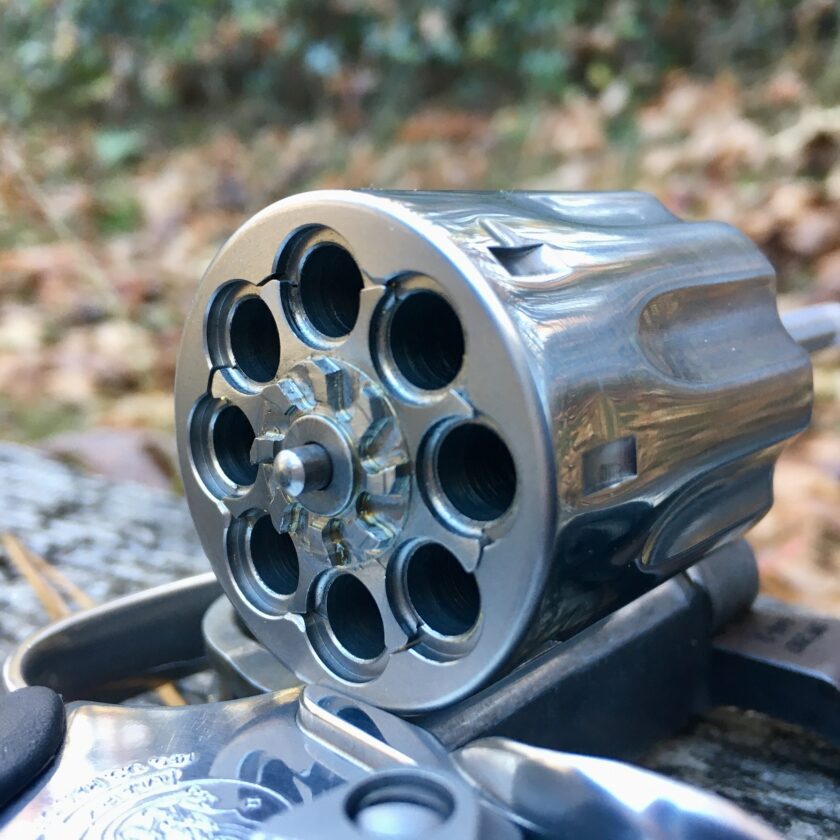
If pressing a rimfire cartridge into service as a defensive round I would like more than six rounds. This is especially true if more than six is easily attainable, as it is in this case. Eight rounds of .22 Magnum is not some magical death ray, but it’s also nothing to sneeze at. As the articles I linked to above point out, .22 Mag seems to punch well above its weight class.
DA/SA Revolver
So why a revolver? Because revolvers are the “ultimate in reliability,” right? Not necessarily. There are a ton of malfunctions a revolver can have: crud under the star, light strikes, backed-out ejector rods, brass under-the-star malfunctions…the list goes on. Revolvers do break and they do malfunction. I don’t mean to imply they don’t work, however. With the relatively small number of rounds fired in a survival situation a revolver will function just fine until you are rescued or find your way out.
Oh, and one other thing: revolvers don’t need magazines. Magazines are expensive. If you’re going to keep one with your survival gear you probably need to rotate it out occasionally. And your magazine(s) can always be dropped, stepped on, get filled with grit just sitting in your pack… And they can get lost. With a revolver you don’t have to worry about that.
The reason I chose a revolver as my ultimate wilderness survival handgun is the .22 Magnum chambering. The hot .22 Mag just doesn’t have a great track record for reliablity out of semi-autos (the new Walther WMP may be an exception). It functions well in revolvers, though. Let’s look at a couple other revolver criteria.
DA/SA
The survival gun should function in both a double-action and single action. Double action because this gun would essentially become my trail gun and assume defensive duties. A double-action revolver can be fired quickly and accurately, and is the preferred method of revolver employment in self defense.
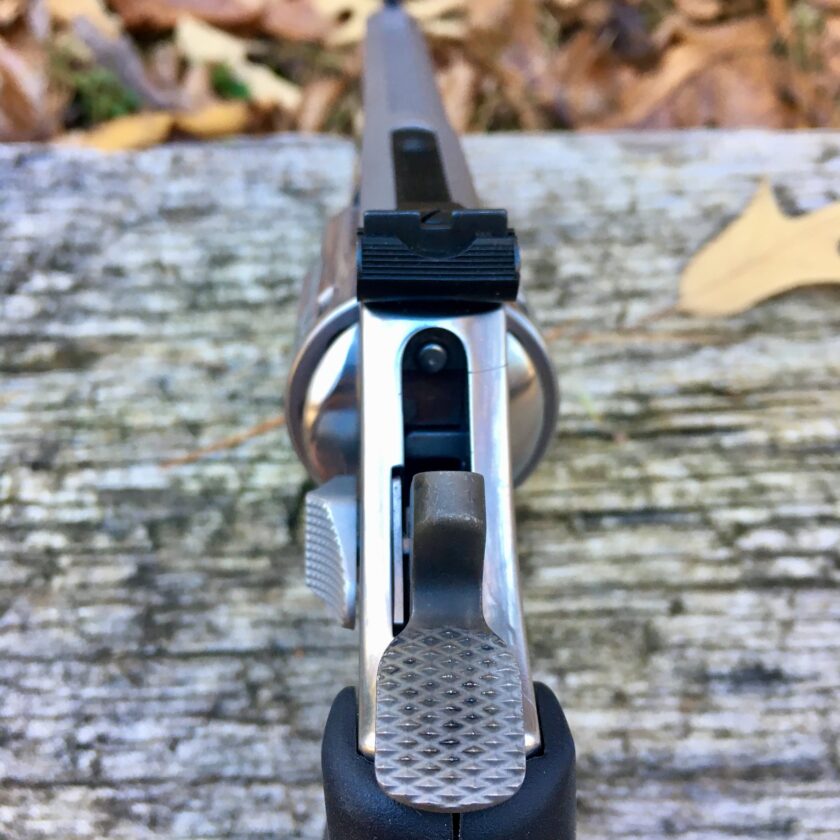
Single action is a hotly debated feature for self-defense revolvers. I’m not a fan but I’m not going to delve into those reasons here. I do think single-action fire has a place on a wilderness survival revolver, however. The ability to take careful, sighted shots at small targets greatly increases your accuracy and hit potential. I’m just more likely to score a hit on a squirrel or rabbit at 20 yards with a 3.5-pound, single action trigger than I am a 12-pound DA trigger with almost an inch of travel.
Barrel, Frame, and Weight
In my criteria above I specified a 4″ barrel, a medium frame, and medium weight. Let’s dig a little deeper into each of those.
Barrel
In my opinion the 4″ barrel is the perfect balance between a hunting/target revolver and a carry revolver. A dedicated hunting/target gun should probably wear a 6″ or so barrel, while 3″ is about the ideal length for a carry revolver. Four inches splits that difference nicely. It gives adequate sight radius for really good accuracy, boosts bullet performance over shorter barrels, and still packs quite nicely. A 4″ barrel is truly the do-it-all barrel length for revolvers, especially when mated to a medium frame.
Frame
I am a big fan of revolvers of the “medium” frame size, like S&W’s K-frame. There aren’t many other revolvers being built in that weight class, but a few are. Most notable are the true S&W K-frames. The Colt King Cobra and Kimber K6 revolvers fit in that category, as do Rock Island’s new AL-series. The medium frame revolvers carry easily but shoot like “real” guns. They have full-sized grips but are quite a bit trimmer than bigger revolvers.
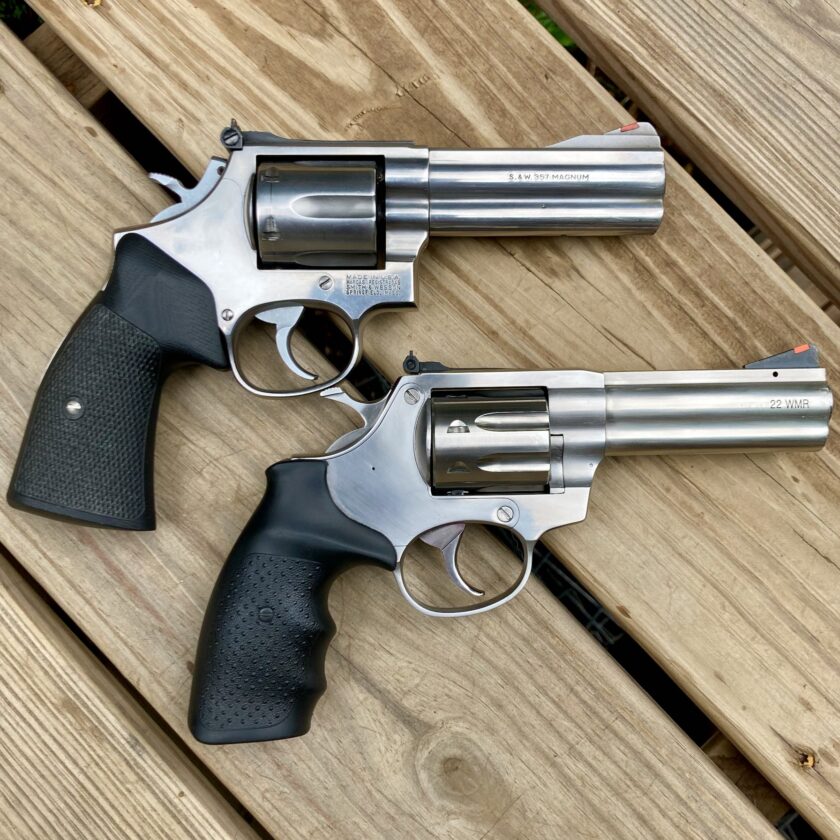
I would also like a grip frame with a round butt. When moving up and downhill, bending to pass under low branches, raising one’s leg high to clear a fallen tree, a sharp gun butt can make itself felt. One of the charms of carrying a revolver is its rounded edges, and a round butt puts a nicely rounded rear corner in the wearer’s side. This is a pretty important feature to comfortable carry.
Medium Weight
The ultimate wilderness survival handgun should be of medium overall weight. I imagine, should a manufacturer undertake such a product, there would be a temptation to make it ultra-light, a la the 17-ounce Ruger LCRx or the 11.7-ounce S&W 317 Kit Gun. A little weight is a good thing, though. It helps to stabilize the gun at extension when attempting a precise shot. It also stabilizes the gun when working the DA trigger; it’s hard to move a 13-lb trigger and not move a 12-ounce gun.
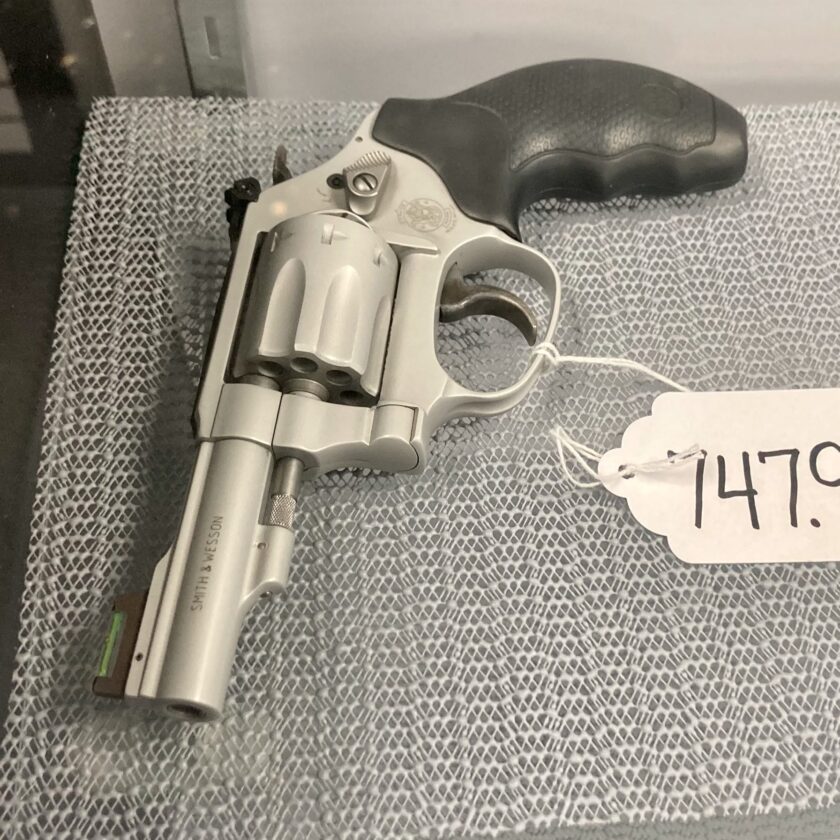
Most .22 Mag revolvers on the market skew the other way. S&W’s Model 48 is a six-shot, 4-inch, K-frame, but comes in at an advertised 38 ounces. Rock Island’s AL22M tips the scales at 39.3 ounces. The Model S&W 648 seems like a worthy contender but it weighs almost 3 pounds – a whopping 46 ounces!
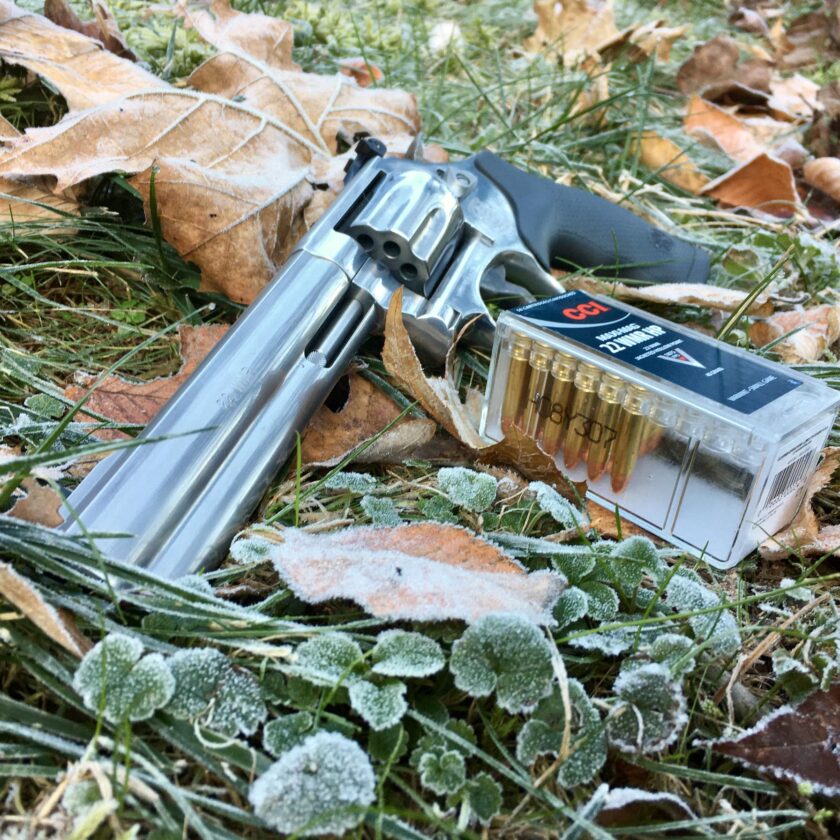
The gun should remain packable on long hikes over arduous terrain. Let’s trim those underlugs (or get rid of them), slim those barrels a bit, use modern materials, and get the overall weight down to something manageable. I would submit that a minimum would be around a pound and a half (24 ounces) with a max weight of two pounds (32 ounces). My preference would be to keep it toward the lower end of that range.
Adjustable Sights
Adjustable sights are absolutely imperative on a revolver intended for survival purposes. The user should be able to regulate them to a chosen load, and move the point of aim to match the point of impact at a given distance (likely 25 yards). The sighs shouldn’t be terribly coarse, nor overly fine. Again, a good middle ground would be desirable, and most modern revolvers achieve this.
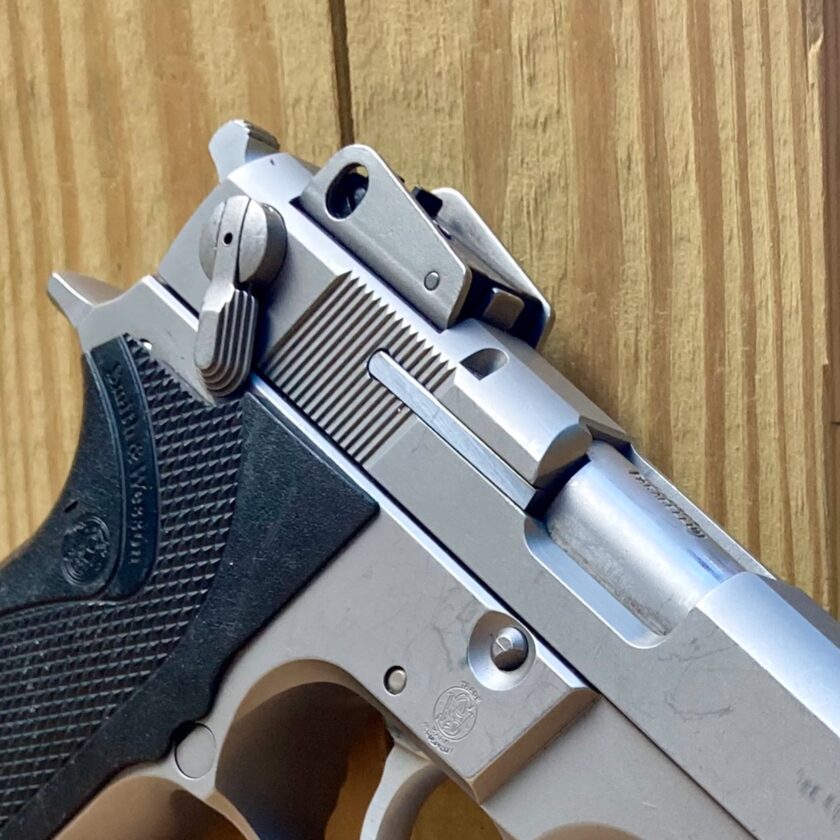
At the risk of asking for something that doesn’t currently really exist, it would be super cool if the rear sight was protected. What I have in mind is something like the rear sights on the old S&W metal autos. I don’t know of a revolver that currently has such a feature. Personally, I think it would be pretty cool – and useful – on a dedicated survival revolver, though. Or maybe we could do with something like Bowen Rough Country sights which are rugged as hell, and look pretty good, too.
Material
The ultimate survival handgun should be impervious to the elements. Or at least as impervious as modern materials can get us. This means stainless, aluminum, titanium, and perhaps even more exotic materials. Not only would the use of something other than carbon steel improve weather resistance, it would also help reduce weight. I think hitting that 24 to 32-ounce sweet spot could be accomplished pretty easily, especially with a reasonably trim barrel sans full underlug.
Grips should also be available in something other than wood. G10 grips from the likes of VZ grips would do nicely. Not only would they not degrade under inclement weather conditions, they would also still provide plenty of anti-slip grip when sweaty, rain-soaked, bloody, or fished out of a river. Rubber grips would do fine, too, but may not be quite as long-lived.
Putting It All Together
None of the criteria I ask for in this missive is completely non-existent on the market. All of the criteria listed here exist in some revolvers (except, possibly, protected rear sights). Unfortunately they all don’t co-habitate in one, single handgun. Let’s look at some of the contenders.
RIA: The one that comes closest currently is the RIA AL22M. I’ve been reviewing this gun for another outlet and really like it. Unfortunately it’s a boat anchor at 39 ounces. Other than that it would be a pretty compelling revolver, but I just don’t want to carry all that steel in the woods. And unfortunately, this revolver has some serious accuracy issues and I would not recommend purchasing it.
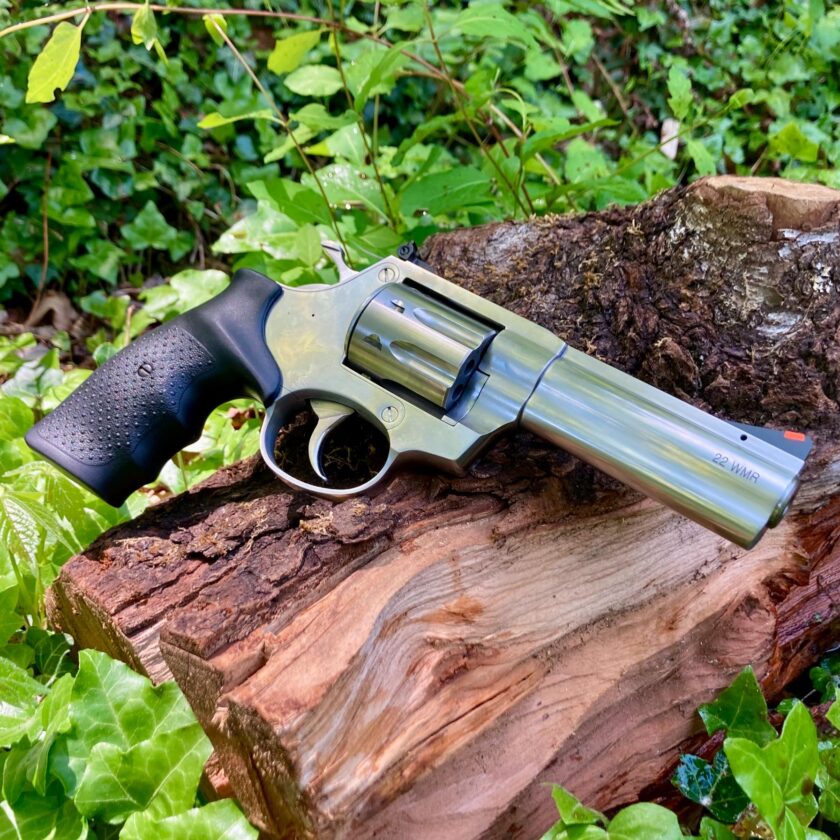
Smith & Wesson: S&W carries a couple .22 Magnum revolvers. The two that come closest to meeting my aims are the Model 48 and the 648. The Model 48 is heavy (38 ounces), only holds six, and is blued. The 648 is big and heavy – I think I’ve hit that enough. Oh, and there’s the .22 LR Model 317 Kit Gun. It’s super neat; if only it and the 648 could have a baby…
Ruger: I mentioned the LCRx above. It’s too light, too short with a 3″ barrel, only holds 6, and is, “ugly as a pair of homemade shoes” (to quote my friend Mike Wood). I think it’s a fine revolver, it just doesn’t meet my aims.
Colt & Kimber: Both companies make excellent mid-sized revolvers. However, all of them are of the .38/.357/.44 persuasion. Should they venture into the rimfire revolver market they have a great head start!
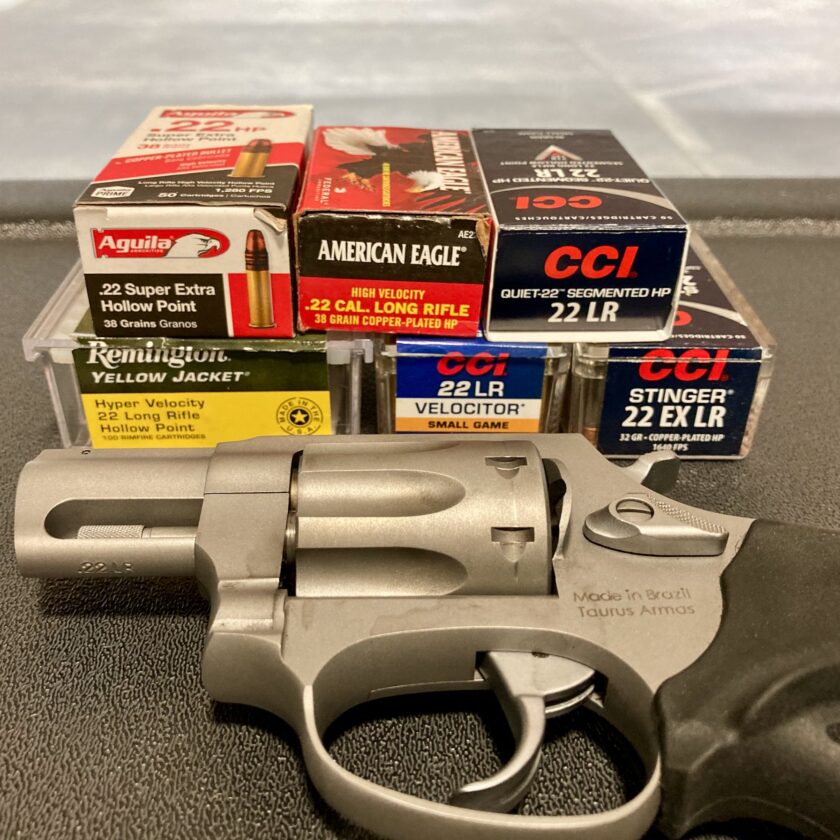
Taurus: Taurus also makes some .22 Magnum revolvers. To be honest I’ve reviewed some of their other rimfire revolvers and have been unimpressed. I’ll pass.
There is one gun on the market that gets really, really close. Let’s take a look at it.
Ultimate Wilderness Survival Handgun: Runner Up
There is a gun that comes so tantalizingly close to meeting all these criteria It is the Ruger SP10 in .22 Long Rifle. The SP101 might be dang near perfect but for the chambering. The only rimfire version of the SP101 is a .22 LR. To be clear I did not write my criteria around this gun – I didn’t even know this model existed until I was almost finished with this article.
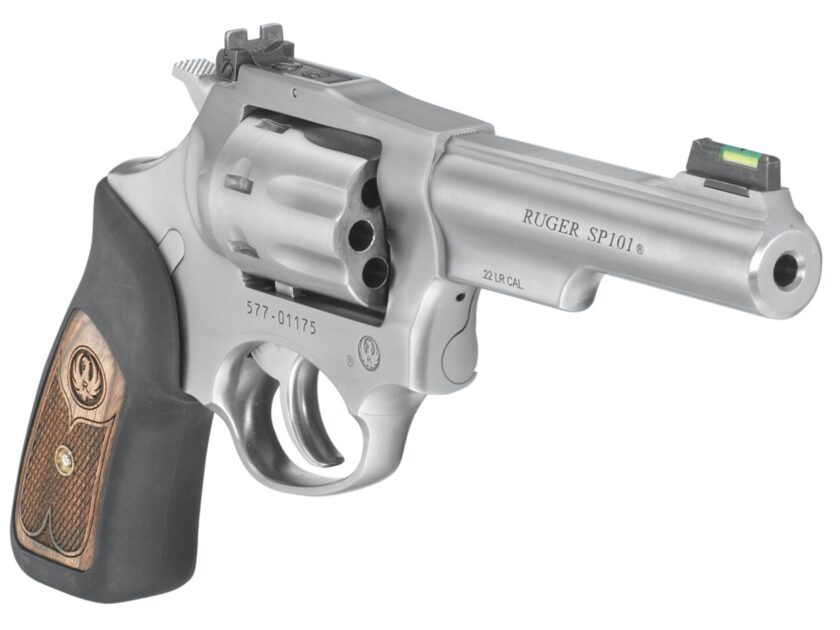
Let’s see how it stacks up against my criteria:
- DA/SA revolver: YES
- chambered in .22 Magnum: NO
- with an 8- or 9-round capacity: YES, 8
- a medium, round-butt frame: YES…in practice. The SP101 is classified as a small-frame revolver, but in practice it’s a big one. And it doesn’t have a “butt”, it has a peg-style grip frame that will accept any number of grip styles and shapes, so it meets the spirit of this criteria.
- a 4″ barrel: CLOSE ENOUGH, actually 4.2″ which I’m willing to bend on.
- medium overall weight: YES at 30 ounces overall it’s two ounces under my proposed maximum weight.
- excellent adjustable sights: YES, they’re pretty good. And I believe the SP101 *may* accept Bowen Rough Country rear sights (don’t quote me on that).
- made of weather-impervious materials: YES, the SP101 is famously robust, constructed of stainless steel, and any number of rubber or G10 grips are available for it.
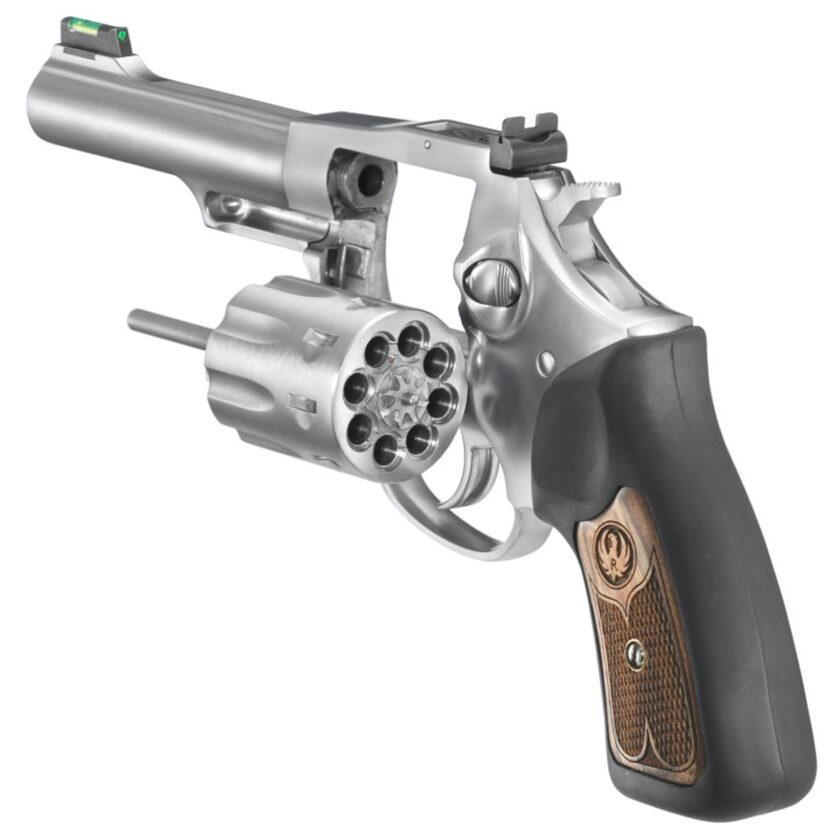
This gun gets so close I can taste it – c’mon, Ruger! Make it in a .22 Mag! If this revolver were chambered for the appropriate cartridge I’d be a thousand dollars poorer by the time you read this.
Closing Thoughts
If you’ve stuck with me until now, thank you – I appreciate your patience! This was a very fun article to write. I’ve been hiking a lot this season, and I’ve been on a few searches and carry-outs. All this walking in the woods has given me a lot of (too much?) time to think. This has been one of my flights of fancy. Seriously, though, I think these criteria would make an awesome trail gun, woods gun, pickup truck gun, and yes, the ultimate wilderness survival handgun.





